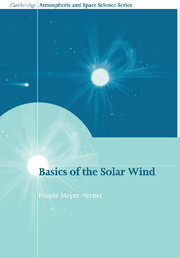Book contents
- Frontmatter
- Contents
- Preface
- 1 The wind from the Sun: an introduction
- 2 Tool kit for space plasma physics
- 3 Anatomy of the Sun
- 4 The outer solar atmosphere
- 5 How does the solar wind blow?
- 6 Structure and perturbations
- 7 Bodies in the wind: dust, asteroids, planets and comets
- 8 The solar wind in the Universe
- Appendix
- Index
2 - Tool kit for space plasma physics
Published online by Cambridge University Press: 22 October 2009
- Frontmatter
- Contents
- Preface
- 1 The wind from the Sun: an introduction
- 2 Tool kit for space plasma physics
- 3 Anatomy of the Sun
- 4 The outer solar atmosphere
- 5 How does the solar wind blow?
- 6 Structure and perturbations
- 7 Bodies in the wind: dust, asteroids, planets and comets
- 8 The solar wind in the Universe
- Appendix
- Index
Summary
Most of the Universe is made of plasma. And yet, plasmas are very rare on the Earth, where solids, liquids and gases – the three primary states of matter – are ubiquitous (Fig. 2.1). These states are the result of a competition between thermal energy and intermolecular forces. In solids, the latter win, maintaining the atoms and/or molecules at nearly fixed positions, whereas thermal energy merely produces vibrations around these positions. In gases on the contrary, thermal energy wins, making the particles almost completely free. Liquids are in between: the intermolecular forces are sufficiently strong to resist compression, but sufficiently weak to enable deformation and flow; it is not surprising that this intermediate state is less well understood than the other two.
Common experience and elementary physics tell us that we may transform a solid into a liquid by heating it; this weakens the bonds between molecules so that they may move slightly, enabling matter to change shape. This requires an amount of energy per molecule somewhat smaller than the binding energy. If the energy furnished exceeds the binding energy, the bonds break out completely, producing a gas of free atoms and/or molecules.
The plasma is the next state: the fourth, reached by furnishing enough energy to break the atoms themselves, or rather to kick off at least the outer atomic electron, producing a mixture of electrons and ions.
- Type
- Chapter
- Information
- Basics of the Solar Wind , pp. 41 - 112Publisher: Cambridge University PressPrint publication year: 2007



